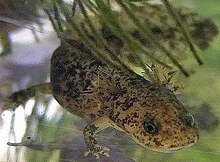Angled newts
| Angled newts | ||||||||||||
|---|---|---|---|---|---|---|---|---|---|---|---|---|

|
||||||||||||
| Systematics | ||||||||||||
|
||||||||||||
| Scientific name | ||||||||||||
| Hynobiidae | ||||||||||||
| Cope , 1859 |
The Asiatic salamander (Hynobiidae), also Asian country salamander called, are quite primitive family of salamanders , whose next extant relatives, the giant salamander are. This superfamily Cryptobranchoidea, which is also known as the “lower tailed amphibians”, differs from other tailed amphibians in features of bone structure, muscles and reproductive biology. It is named after the fact that among other things in the genus Hynobius the palatal teeth on the roof of the mouth form an M-shaped figure.
features
Most types of angle-toothed newts are small, not even four inches long. Ranodon sibiricus , the largest species, becomes a maximum of 25 cm long. In the lower jaw, pre-articular and angular bones are separate from one another; in the upper jaw, maxillary and premaxillary are present. Adults have neither gills nor gill slits. Your eyelids are movable. The lungs are usually well developed but are absent in Onychodactylus .
distribution
The family has an east Palearctic distribution area, which mainly includes Siberia from the Urals to Sakhalin and the Kamchatka Peninsula . In addition, the animals come in a large part of Manchuria , in central China between Yellow River and Yangtze River , in a small area in the northwest of Xinjiang , on Taiwan , Korea and Japan, in the northwest of Afghanistan and the southern Iranian coast of the Caspian Sea before . Most species live north of 40 ° N . The Siberian angle-toothed newt ( Salamandrella keyserlingii ) is the only species that also reaches the European part of Russia .
Way of life
Apart from the breeding season, which the animals spend in ponds, pools and streams, most of the angular-toothed newt species live terrestrially, which now predominantly live in moist habitats (often in mountainous regions). The female gives off gelatinous “spawning bags” which are fertilized externally by the male and, in some species, are then guarded. In contrast to the giant salamanders, angle-toothed newts go through the complete aquatic larval development with the completion of a metamorphosis to gillless, adult land salamanders.
Taxonomy
The family is currently divided into two subfamilies and nine genera with just over 50 species.

- Subfamily Hynobiinae
- Genus Batrachuperus - Asiatic mountain newts (with 5 or 6 species)
- Genus Hynobius (with 32 species)
- Genus Liua (with 7 species)
- Genus Pachyhynobius (with 1 species)
- Genus Paradactylodon (with 3 species)
- Genus Pseudohynobius (with 6 species)
- Genus Ranodon - frog-tooth newts (with 1 species)
- Genus Salamandrella (with 2 species)
- Subfamily Onychodactylinae
- Genus Onychodactylus (with 8 species)
Individual evidence
- ↑ a b c d Laurie J. Vitt and Janalee P. Caldwell: Herpetology: An Introductory Biology of Amphibians and Reptiles. Academic Press, 2013, ISBN 978-0123869197 , page 460.
- ↑ AmphibiaWeb: Salamandrella keyserlingii Siberian Newt
- ↑ AmphibiaWeb: Family Hynobiidae